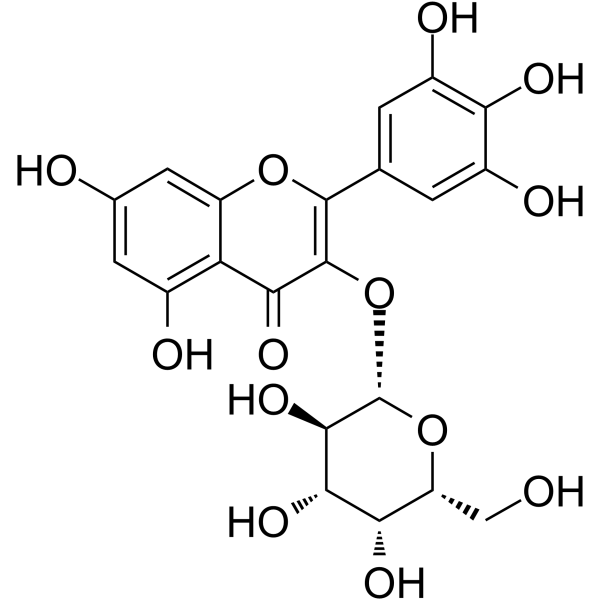
Myricetin 3-O-galactoside
CAS No. 15648-86-9
Myricetin 3-O-galactoside( —— )
Catalog No. M31158 CAS No. 15648-86-9
Myricetin 3-O-galactoside can inhibit xanthine oxidase (xanthine oxidase; XO) activity, lipid peroxidation and scavenging free radicals.
Purity : >98% (HPLC)
 COA
COA
 Datasheet
Datasheet
 HNMR
HNMR
 HPLC
HPLC
 MSDS
MSDS
 Handing Instructions
Handing Instructions
| Size | Price / USD | Stock | Quantity |
| 5MG | 484 | In Stock |


|
| 10MG | 699 | In Stock |


|
| 50MG | Get Quote | In Stock |


|
| 100MG | Get Quote | In Stock |


|
Biological Information
-
Product NameMyricetin 3-O-galactoside
-
NoteResearch use only, not for human use.
-
Brief DescriptionMyricetin 3-O-galactoside can inhibit xanthine oxidase (xanthine oxidase; XO) activity, lipid peroxidation and scavenging free radicals.
-
DescriptionMyricetin 3-O-galactoside can inhibit xanthine oxidase (xanthine oxidase; XO) activity, lipid peroxidation and scavenging free radicals. Myricetin 3-O-galactoside has many effects, including cytotoxicity, anti-oxidation, anti-genotoxicity, anti-infectivity, anti-inflammatory and antioxidant activities, and its main effect is to inhibit the synthesis of inducible nitric oxide synthase (iNOS). The IC50 of Myricetin 3-O-galactoside inhibited lipid peroxidation was 160 μg/mL.
-
In Vitro——
-
In Vivo——
-
Synonyms——
-
PathwayOthers
-
TargetOther Targets
-
Recptor——
-
Research Area——
-
Indication——
Chemical Information
-
CAS Number15648-86-9
-
Formula Weight480.38
-
Molecular FormulaC21H20O13
-
Purity>98% (HPLC)
-
SolubilityIn Vitro:?DMSO : 50 mg/mL (104.08 mM)
-
SMILES——
-
Chemical Name——
Shipping & Storage Information
-
Storage(-20℃)
-
ShippingWith Ice Pack
-
Stability≥ 2 years
Reference
molnova catalog



related products
-
IRBP
Interphotoreceptor Retinoid Binding Protein Fragment (IRBP) is a 20-residue peptide, which is a major pathogenic epitope. It exists in the first homologous repeat of interstitial visual pigment Binding Protein peptide (IRBP 161-180) and can induce post-uveitis (EAU).
-
Antrodin A
Antrodin A (AdA) is one of the main active ingredients in the solid-state fermented A. camphorata mycelium.?It protects the liver from alcohol damage by improving the antioxidant and anti-inflammatory capacity of the liver and maintaining the stability of the intestinal flora.
-
3-Galloylquercitrin
1. 3''-Galloylquercitrin possesses the activity for PTK inhibition.



 Cart
Cart
 sales@molnova.com
sales@molnova.com


